
Mayo Clinic researchers have successfully isolated nanoparticles from human kidney stones in cell cultures and have isolated proteins, RNA and DNA that appear to be associated with the nanoparticles. Reporting in the Journal of Investigative Medicine, the researchers say the findings could lead to solving the mystery of whether nanoparticles are viable living forms that can lead to disease – in this case, kidney stones.
The existence of living nanoparticles – or more controversially, nanobacteria – is a hotly debated topic in scientific circles. Isolating a genetic signature – which would indicate that the entities were indeed alive – has proven problematic, and what would appear to be successful laboratory culturing of the entities has in the past been discounted as simple crystal growth. Now, however, Mayo Clinic researchers believe they have isolated genetic material from the entities and in this case linked them with the formation of kidney stones.
Kidney stones are associated with calcification, the process in which organs and blood vessels become clogged with calcium deposits.
“We are looking at how kidney stones start as very small calcifications inside the kidney and then eventually grow into stones,” said Mayo Clinic’s John Lieske. “In the laboratory, we have isolated nanoparticles from kidney tissue and kidney stones, and have successfully propagated them in culture. This does not clearly confirm the role of nanoparticles in the formation of kidney stones, but it offers insight not otherwise known.”
It’s theorized that if nanoparticles become localized in the kidney, they can become the focus of subsequent growth into larger stones over months to years. Other factors, such as physical chemistry and protein inhibitors of crystal growth, also play a role. But what scientists don’t quite understand is why, where and how they start growing.
Frustratingly, the presence of proteins, RNA and DNA does not prove that nanoparticles are viable living forms because a genetic signature has not been identified, explains Lieske. A genetic signature would prove beyond doubt that nanoparticles are indeed living forms that replicate and can cause disease.
Intriguingly, the study cites evidence that the calcification process is not driven solely by physical chemistry, but instead is influenced by specific proteins and cellular responses. “There are at least two novel hypotheses here in terms of how stones might actually form. One: an infectious agent. If that was the case, that would point us in the direction of using different kinds of treatments specific to an infectious agent. Two: the idea that cells drive calcification. That would suggest other alternative therapies,” added co-researcher Virginia Miller.
Another study by the Mayo Clinic researchers in the same journal documents attempts to identify a DNA chemical marker in nanoparticles. The preliminary study suggests that nanoparticles from human samples share spectroscopic characteristics with calcified bacteria that exist in freshwater lakes. However, studies could not confirm whether the nanoparticles are calcified bacteria or hydroxyapatite crystals that precipitated upon proteins present in the culture medium used to replicate the nanoparticles. Researchers did, however, identify chemical bonds between proteins and calcium in nanoparticles that were similar to those found in the bacteria that calcified in the environment. “Right now the results are inconclusive. In some of the segments we saw a characteristic signal that might suggest DNA, but in others we did not,” Miller said.
Miller added that the tools and processes used in nanoparticle research have yet to be perfected. “We are still in the learning process of how to handle the material. It was disappointing that we did not find any consistent DNA information. We think the findings were inconclusive, in part, because of the inability to apply these techniques in conditions suitable to nanoparticles,” she concluded.
Related Articles
Nanobacteria A Problem For Space Travellers, Says NASA
More Evidence For NanoBacteria Say Researchers
Airborne Nanobacteria Spread Disease, Create Rain








Comments are closed.